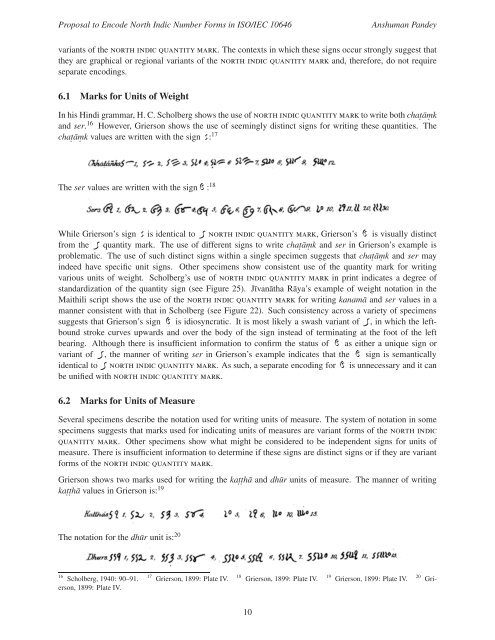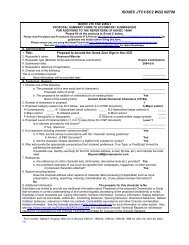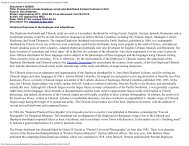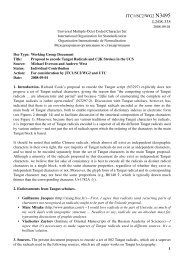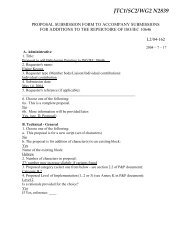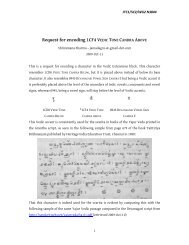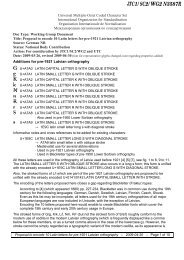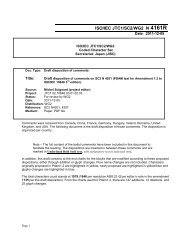Common Indic Number Forms - dkuug
Common Indic Number Forms - dkuug
Common Indic Number Forms - dkuug
Create successful ePaper yourself
Turn your PDF publications into a flip-book with our unique Google optimized e-Paper software.
Proposal to Encode North <strong>Indic</strong> <strong>Number</strong> <strong>Forms</strong> in ISO/IEC 10646 Anshuman Pandey<br />
variants of the north indic quantity mark. The contexts in which these signs occur strongly suggest that<br />
they are graphical or regional variants of the north indic quantity mark and, therefore, do not require<br />
separate encodings.<br />
6.1 Marks for Units of Weight<br />
In his Hindi grammar, H. C. Scholberg shows the use of north indic quantity mark to write both chat.ām. k<br />
and ser. 16 However, Grierson shows the use of seemingly distinct signs for writing these quantities. The<br />
chat.ām. k values are written with the sign ð: 17<br />
The ser values are written with the sign ô: 18<br />
While Grierson’s sign ð is identical to ÷ north indic quantity mark, Grierson’s ô is visually distinct<br />
from the ÷ quantity mark. The use of different signs to write chat.ām. k and ser in Grierson’s example is<br />
problematic. The use of such distinct signs within a single specimen suggests that chat.ām. k and ser may<br />
indeed have specific unit signs. Other specimens show consistent use of the quantity mark for writing<br />
various units of weight. Scholberg’s use of north indic quantity mark in print indicates a degree of<br />
standardization of the quantity sign (see Figure 25). Jīvanātha Rāya’s example of weight notation in the<br />
Maithili script shows the use of the north indic quantity mark for writing kanamā and ser values in a<br />
manner consistent with that in Scholberg (see Figure 22). Such consistency across a variety of specimens<br />
suggests that Grierson’s sign ô is idiosyncratic. It is most likely a swash variant of ÷, in which the leftbound<br />
stroke curves upwards and over the body of the sign instead of terminating at the foot of the left<br />
bearing. Although there is insufficient information to confirm the status of ô as either a unique sign or<br />
variant of ÷, the manner of writing ser in Grierson’s example indicates that the ô sign is semantically<br />
identical to ÷ north indic quantity mark. As such, a separate encoding for ô is unnecessary and it can<br />
be unified with north indic quantity mark.<br />
6.2 Marks for Units of Measure<br />
Several specimens describe the notation used for writing units of measure. The system of notation in some<br />
specimens suggests that marks used for indicating units of measures are variant forms of the north indic<br />
quantity mark. Other specimens show what might be considered to be independent signs for units of<br />
measure. There is insufficient information to determine if these signs are distinct signs or if they are variant<br />
forms of the north indic quantity mark.<br />
Grierson shows two marks used for writing the kat.t.hā and dhūr units of measure. The manner of writing<br />
kat.t.hā values in Grierson is: 19<br />
The notation for the dhūr unit is: 20<br />
16<br />
Scholberg, 1940: 90–91.<br />
erson, 1899: Plate IV.<br />
17 Grierson, 1899: Plate IV.<br />
18 Grierson, 1899: Plate IV.<br />
10<br />
19 Grierson, 1899: Plate IV.<br />
20 Gri


